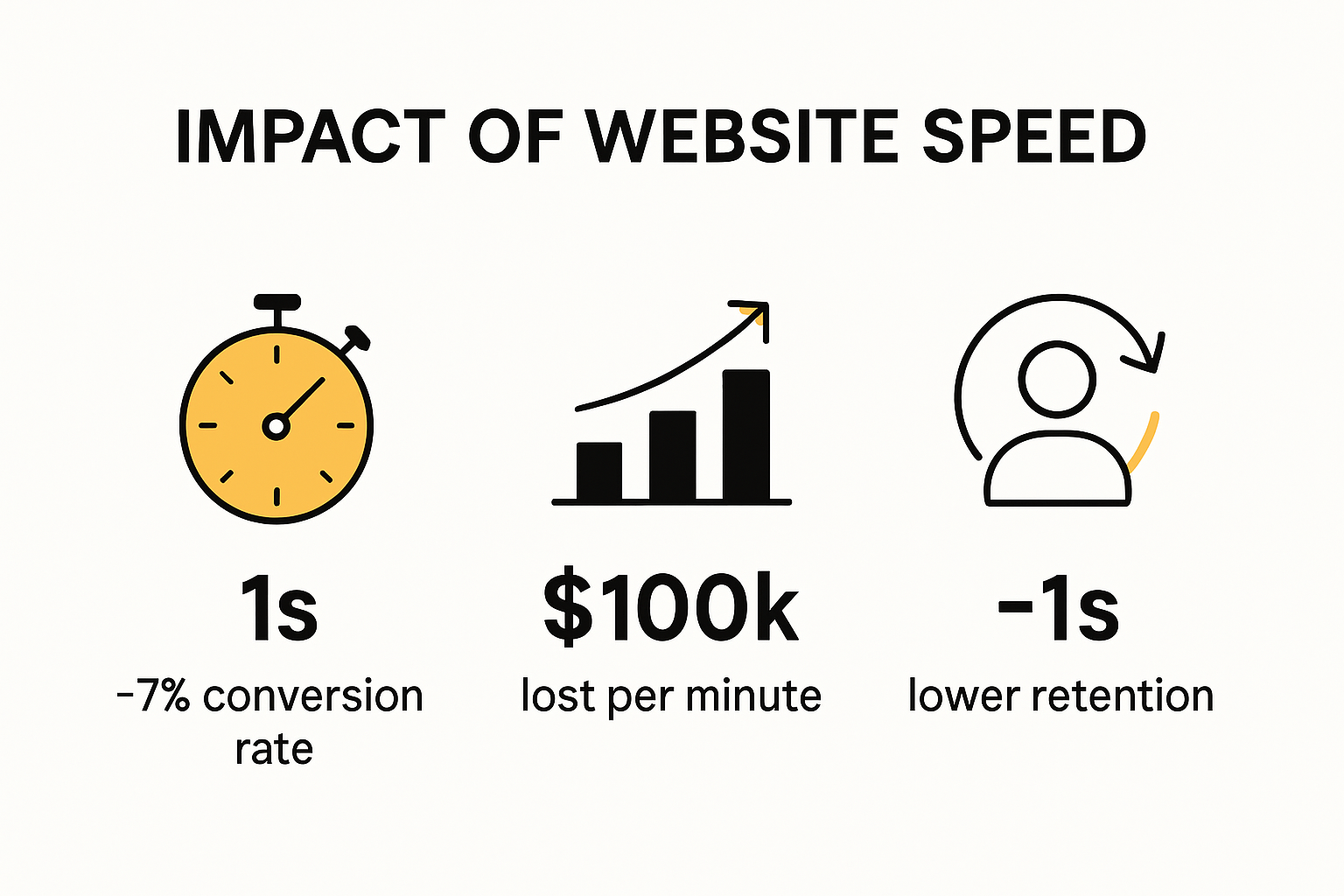How to Boost Website Speed in 2025: Proven Tips for SMBs & Marketers


Website speed is now the silent dealbreaker for small businesses and marketers hungry for growth. Here is a jaw-dropping stat: a one-second delay in load time can drop your conversions by 7 percent and cost companies $2.6 billion every year. It sounds like a technical issue best left for IT teams. Surprisingly, the real winners in 2025 will be those who treat website speed as a marketing power play, not just a background fix. Curious how lightning-fast websites become revenue machines? Here’s what you need to know.
Table of Contents
- Why Website Speed Matters For Growth
- Quick Fixes To Instantly Increase Loading Speed
- Advanced Strategies For Long-Term Performance
- Essential Tools To Monitor And Test Speed
Quick Summary
| Takeaway | Explanation |
|---|---|
| Website speed significantly affects business growth | A one-second delay can reduce conversions by 7%, resulting in billions of dollars in lost revenue annually, emphasizing the need for optimized loading times in competitive markets. |
| Implement quick fixes for immediate speed improvements | Utilize Content Delivery Networks (CDNs) to reduce latency, optimize resource loading by compressing images and minifying code, and adhere to Core Web Vitals guidelines for better performance metrics. |
| Invest in advanced strategies for long-term performance | Build a robust infrastructure with modern hosting technologies, adopt intelligent content delivery strategies, and prioritize mobile-first technical SEO to meet evolving user expectations and ensure consistent speed. |
| Leverage effective tools for ongoing performance monitoring | Use tools like Google PageSpeed Insights for basic evaluations, and advanced options like GTmetrix for comprehensive diagnostics to continuously assess and optimize website performance. |

Why Website Speed Matters for Growth
In the digital ecosystem, website speed represents more than a technical metric—it's a critical driver of business growth and user engagement. Website performance directly impacts how potential customers perceive and interact with your online presence.
The Economic Impact of Speed
The financial consequences of slow websites are substantial. Research from Site Builder Report reveals that a single second of delay can decrease conversions by 7%, translating to nearly $2.6 billion in lost revenue annually. This stark statistic underscores the profound connection between loading times and bottom-line performance.
User expectations have become increasingly demanding. New Target Web Insights indicates that by 2025, users consider anything over three seconds as "slow," with sub-one-second load times now representing the gold standard. This ultra-competitive digital environment means businesses cannot afford to neglect website performance.
User Experience and Retention
Beyond immediate financial implications, website speed fundamentally shapes user experience and long-term customer relationships. Electro IQ statistics demonstrate that 79% of users who encounter a poor website experience will not return, with 64% actively choosing a competitor instead. These numbers reveal a harsh reality: slow websites don't just lose immediate conversions—they permanently damage brand reputation.
For small to medium-sized businesses, website speed represents a critical competitive advantage. Faster websites not only retain users but also signal professionalism, technological competence, and customer-centric design. Search engines like Google recognize this, incorporating page speed as a significant ranking factor. This means improved website performance can simultaneously enhance user experience and search visibility.
Technical Performance as a Growth Strategy
Consider website speed an investment, not an expense. Quick-loading pages reduce bounce rates, increase engagement, and create positive first impressions. Mobile users are particularly sensitive to performance, with Google research showing that 53% of mobile users abandon sites taking longer than three seconds to load.
Businesses that prioritize website speed position themselves for sustainable digital growth. By understanding and implementing performance optimization strategies, organizations can transform technical infrastructure into a powerful marketing tool that attracts, retains, and converts customers more effectively.
The message is clear: in 2025 and beyond, website speed isn't just a technical consideration—it's a fundamental driver of business success.
Quick Fixes to Instantly Increase Loading Speed
Website speed optimization requires strategic, targeted interventions that deliver immediate performance improvements. Small to medium-sized businesses can implement several quick fixes to dramatically enhance their website loading times and user experience.

Leverage Content Delivery Networks
Debug Bear research highlights the transformative power of Content Delivery Networks (CDNs) in reducing server connection times. CDNs work by distributing website resources across multiple global servers, enabling faster content delivery by serving files from locations closest to the user. This approach significantly reduces latency and speeds up website loading.Implementing a CDN is straightforward and can yield instant performance gains. By caching static resources like images, CSS, and JavaScript files across different geographic locations, websites can reduce server response times and provide a more consistent experience for users worldwide. Some CDN providers offer easy integration and immediate speed improvements without complex technical configurations.
Optimize Resource Loading
Performance experts emphasize the critical importance of minimizing unnecessary resource loading. Every additional script, image, or external resource can potentially slow down your website. Prioritizing critical rendering assets and deferring non-essential resources can create substantial speed improvements.Specific optimization strategies include:
- Compress Images: Reduce image file sizes without compromising quality using modern compression techniques.
- Minify CSS and JavaScript: Remove unnecessary characters and whitespace from code files.
- Eliminate Render-Blocking Resources: Restructure how scripts and stylesheets load to prevent delays in page rendering.
Implement Core Web Vitals Recommendations
Google's Core Web Vitals provide a comprehensive framework for measuring and improving website performance. These metrics focus on three critical aspects of user experience: loading performance, interactivity, and visual stability.Key recommendations include:
- Largest Contentful Paint (LCP): Aim to load the main content within 2.5 seconds.
- First Input Delay (FID): Ensure interactive elements respond within 100 milliseconds.
- Cumulative Layout Shift (CLS): Minimize unexpected layout movements during page load.
By systematically addressing these performance metrics, businesses can create faster, more responsive websites that keep users engaged. Regular speed testing and continuous optimization are crucial in maintaining peak website performance.
Remember, website speed is not a one-time fix but an ongoing process of refinement and improvement. Small, incremental changes can collectively result in significant performance enhancements that directly impact user satisfaction and business growth.
Advanced Strategies for Long-Term Performance
Optimizing website performance requires a holistic, forward-thinking approach that goes beyond quick fixes. Advanced strategies focus on creating a robust, scalable infrastructure that ensures consistent speed and exceptional user experience across evolving digital landscapes.
Modern Hosting Infrastructure
New Target Web Insights emphasizes the critical role of advanced hosting technologies in long-term website performance. Investing in cutting-edge hosting solutions like SSD or NVMe storage dramatically improves data retrieval speeds, providing a solid foundation for website responsiveness.Key infrastructure considerations include:
- Server-Level Caching: Implementing technologies like Redis or Varnish to reduce database query times and accelerate content delivery.
- HTTP/3 Protocol: Adopting the latest network protocol that offers improved connection establishment and reduced latency.
- Auto-Scaling Environments: Creating flexible hosting solutions that automatically adjust resources based on traffic fluctuations.
Strategic Content Delivery and Optimization
Debug Bear research highlights the transformative potential of sophisticated Content Delivery Networks (CDNs). Advanced CDN strategies go beyond basic caching, offering intelligent content distribution that adapts to user geography, device characteristics, and network conditions.Comprehensive optimization techniques include:
- Edge Computing: Leveraging global edge servers to process and deliver content closer to end-users.
- Intelligent Caching Mechanisms: Implementing dynamic caching strategies that balance fresh content with performance efficiency.
- Adaptive Image and Resource Delivery: Automatically serving optimized content formats based on device capabilities.
Mobile-First Technical SEO
Beetle Beetle Performance Research underscores the importance of a mobile-first approach in long-term website performance. With mobile devices dominating internet access, businesses must prioritize technical optimization that caters to mobile user experiences.Advanced mobile-optimization strategies encompass:
- Responsive Design: Creating fluid layouts that seamlessly adapt to different screen sizes and resolutions.
- Performance Budgeting: Setting strict performance metrics for page load times, resource sizes, and rendering speeds.
- Advanced Lazy Loading: Implementing sophisticated techniques that intelligently load content as users interact with the page.
By integrating these advanced strategies, businesses create a dynamic, high-performance web infrastructure that not only meets current user expectations but anticipates future technological demands. Continuous monitoring, regular performance audits, and a commitment to technological innovation are key to maintaining a competitive digital presence.
Remember, long-term website performance is an ongoing journey of optimization, adaptation, and strategic investment. The most successful businesses view website speed as a critical component of their overall digital strategy, not just a technical checkbox.
Essential Tools to Monitor and Test Speed
Effective website performance management requires robust monitoring and testing tools that provide comprehensive insights into loading speeds, potential bottlenecks, and optimization opportunities. Small to medium-sized businesses can leverage a range of powerful tools to diagnose and improve their website performance strategically.
Free Performance Analysis Tools
Google PageSpeed Insights offers a comprehensive, free solution for website speed evaluation. This powerful tool provides detailed performance scores for both desktop and mobile platforms, generating actionable recommendations that help businesses identify and resolve speed-related issues.Key features of performance analysis tools include:
- Detailed Performance Scoring: Evaluate website speed on a 0-100 scale
- Device-Specific Insights: Separate analysis for mobile and desktop experiences
- Specific Optimization Recommendations: Targeted suggestions for improving load times
Advanced Monitoring and Reporting
Pingdom's Website Speed Test delivers advanced reporting capabilities that go beyond basic speed measurements. UptimeRobot complements these insights by providing continuous monitoring of website performance and server health.Advanced monitoring tools offer:
- Waterfall Charts: Visualize precise loading times for individual resources
- Geographical Performance Tracking: Understand how website speed varies across different locations
- Real-Time Alert Systems: Immediate notifications about performance degradation
Comprehensive Performance Diagnostics
GTmetrix represents a sophisticated platform that combines multiple performance testing methodologies. This tool integrates insights from Google Lighthouse and provides in-depth analysis of website speed, optimization potential, and user experience metrics.Comprehensive diagnostic features include:
- Performance Grade Breakdown: Detailed scoring across multiple performance categories
- Resource Loading Analysis: Identify specific elements causing slowdowns
- Historical Performance Tracking: Monitor website speed improvements over time
Choosing the right performance monitoring tools requires understanding your specific business needs. While free tools provide excellent initial insights, professional-grade solutions offer more nuanced diagnostics and continuous monitoring capabilities.
Professional tip: Rotate between different testing tools to gain a comprehensive understanding of your website's performance. Each tool uses slightly different measurement methodologies, providing a more holistic view of potential optimization opportunities.
Remember that website speed monitoring is not a one-time task but an ongoing process. Regular testing, continuous optimization, and staying informed about emerging performance technologies are crucial for maintaining a competitive digital presence.
Frequently Asked Questions
What are the main reasons website speed is important for SMBs in 2025?
Website speed is crucial for SMBs as a one-second delay can decrease conversions by 7%, leading to significant revenue loss. Faster websites improve user experience, increase customer retention, and enhance search engine rankings, making speed a critical component of digital growth.
How can I quickly improve my website's loading speed?
You can improve website speed by leveraging Content Delivery Networks (CDNs), optimizing resource loading by compressing images and minifying code, and adhering to Core Web Vitals recommendations such as improving Largest Contentful Paint (LCP).
What advanced strategies should SMBs consider for long-term website performance?
For long-term performance, SMBs should invest in modern hosting infrastructure, such as SSD storage and auto-scaling environments, adopt strategic content delivery methods, and focus on mobile-first technical SEO to enhance user experience.
What tools can I use to monitor my website's speed effectively?
You can use tools such as Google PageSpeed Insights for basic performance analysis, GTmetrix for comprehensive diagnostics, and Pingdom for advanced monitoring to identify speed-related issues and track improvements over time.
Ready to Turn Lightning Speed Into Lasting Growth?
You just learned that even a single second of slow load time can slash your conversions and make visitors run to your competitors. The struggle to maintain peak website speed is real for small businesses and marketers. Optimizing images and using CDNs are great steps, but the real challenge is keeping up a blazing-fast site while also producing fresh, SEO-rich content that search engines love. Most teams are stretched thin and falling behind in content or technical optimization can quickly erase your hard-won website gains.

Imagine if you could automate the hardest part—creating fully optimized, search-friendly articles that give you both speed and visibility. BabyLoveGrowth.ai analyzes your business, builds a custom 30-day SEO content plan, and generates high-performance articles in minutes. No more time lost on manual tasks or worrying about technical content bottlenecks. Give your site the fuel to rank higher and load faster. Take the first step and see how BabyLoveGrowth.ai can elevate your digital growth today.
Smart SEO,
Faster Growth!
Most Read Articles

Generative Engine Optimization (GEO)
Learn how Generative Engine Optimization (GEO) helps your content rank in AI search engines like ChatGPT and Google AI. This comprehensive guide explains the differences between SEO and GEO, why it matters for your business, and practical steps to implement GEO strategies for better visibility in AI-generated responses.

Track LLM Traffic in Google Analytics 4 (GA4)
Learn how to track and analyze traffic from AI sources like ChatGPT, Claude, Perplexity, and Google Gemini in Google Analytics 4. This step-by-step guide shows you how to set up custom filters to monitor AI-driven traffic and make data-driven decisions for your content strategy.

How to Humanize AI Text with Instructions
Learn practical techniques to make AI-generated content sound more natural and human. This guide covers active voice, direct addressing, concise writing, and other proven strategies to transform robotic text into engaging content.

Open AI Revenue and Statistics (2024)
Comprehensive analysis of OpenAI financial performance, user engagement, and market position in 2023. Discover key statistics including $20B valuation, $1B projected revenue, and 100M+ monthly active users.